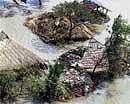

They can’t quite put their finger on it. But weather scientists know several factors are at play, disturbing the air circulation pattern over India. Circulation of air helps distribute heat over earth, thus, any change in it throws up surprises. This year there were many.
Heat waves scorched Orissa and West Bengal in April—it usually happens in May or June.
Winter rain gave a miss to the northeast. By the end of April, the heat wave was reported to have killed over 70 people in Orissa and nine in West Bengal.
In West Bengal’s Purulia, mercury soared to 49°C on April 21, four degrees more than the average maximum for the month there. In Orissa, it touched 46°C on April 20, six degrees more than the average maximum.
Weathermen say a cyclonic storm called Bijli that formed in the Bay of Bengal around April 15, was responsible for the hot spell. As it moved towards Bangladesh, it intersected and cut off cool easterly winds blowing from the Bay of Bengal to Orissa and West Bengal. The easterly winds keep the eastern coast cool, but in their absence north-western desert winds blowing from Rajasthan prevailed, heating coastal states.
“Something similar happened last year. Temperature in Orissa shot to 45°C in the last week of April. That year too, a cyclonic storm in the Bay of Bengal cut off the easterlies.
“Similar events in two continuous years do not establish a trend, but they do give us enough reason to investigate whether there is a pattern in cyclones cutting off easterlies and leading to heat waves,” said M Rajeevan, scientist at the National Atmospheric Research Laboratory in Tirupati.
Heat waves across the country
Hot spells are increasing in other parts of the country too. The department has clubbed its observation centres into 35 subdivisions. On compiling daily data on heat wave conditions over subdivisions, the researchers found that between 1991 and 2000, 22.7 subdivisions were hit by heat waves per year, while between 1971 and 1980, an average of 9.9 subdivisions were hit by heat waves per year. In 1981-1990, the average was 7.3.
The study, published in the April 2004 issue of IMD journal Mausam, showed more areas suffered frequent heat waves in 1991-2000 compared to earlier decades. Twenty-five subdivisions went through more than 15 spells of heat waves during 1991-2000. In the earlier two decades two subdivisions received over 15 spells of heat waves.
It is the same with the duration of heat waves. During 1991-2000, the highest duration was 16 days, while in the previous decade the longest heat wave was of nine days and a decade before that, 11 days.
Steeper this decade
“Though we have not studied it thoroughly, our observation indicates the increase was steeper this decade,” said D S Pai, lead author of the study and scientist at IMD.
The IMD Pune scientist’s observations were corroborated by a study by Rajeevan. It said the number of heat wave days per year in central and north-west India increased from three to 12 between 1969 and 2005.
One reason behind the increase could be different parts of the earth warming at different rates; it is likely to bring frequent changes in air circulation, said Rajeevan. Pai explains that an anticyclone prevails over India, with its centre hovering around Rajasthan and a little north of it.
Anticyclones are centres of high pressure from where winds blow out in every direction.
The anticyclone over India sends warm winds from north-west to central and western India, causing heat waves.
“Scientists say the anticyclone was also partially responsible for heat waves on the eastern coast of India. Even though Bijli cut off the cool easterlies, the heat wave would not have been this intense if there was no anticyclonic wind pattern prevailing over India,” said A K Srivastava, another scientist at IMD in Pune.
But why did heat waves come so early? They are—or were—rare in April. Rajeevan offers an explanation: “The cyclone may have developed in April because of early rise of temperature which also heated the sea.”
Meteorological data of the past 100 years shows March and April are warming faster than May and June, which are the hottest summer months. The average temperature for March has increased by 0.76°C over the last century; that for April has increased by 0.58°C; and in both May and June, the increase has been 0.17°C. This has taken place over the last three decades, said Srivastava.
Sharper in north India
A study in Current Science said the increase was sharper in north India than in the south. Preliminary calculations by D R Pattanaik, scientist at IMD in Delhi, show that in coastal Andhra Pradesh, May temperatures in the past decade have risen significantly, while temperatures in June have dropped somewhat. But in Assam, temperatures from February to June have risen similarly.
The state receives an average of 25 mm rainfall per month in winter. But this year there was negligible rainfall between November and February. In March, Assam experienced four severe dust storms.
Some scientists have attributed the abnormally dry winters to fewer western disturbances reaching the region. Rajendra Hathwar, additional director general at IMD Pune, explains that most of the western disturbances had a more northerly track this year.
The winds showered rains over Jammu and Kashmir but even Himachal Pradesh, Uttarakhand, Punjab and adjoining states had deficient rainfall this winter. They touched Arunachal Pradesh to some extent and should have affected Assam in end February and March, but did not.
Srivastava said this may be due to abnormal heating of the Tibetan plateau. The plateau was warmer than normal by two degrees this February, added Pattanaik. When a plateau heats up, winds over it move horizontally unlike upwards in the plains.